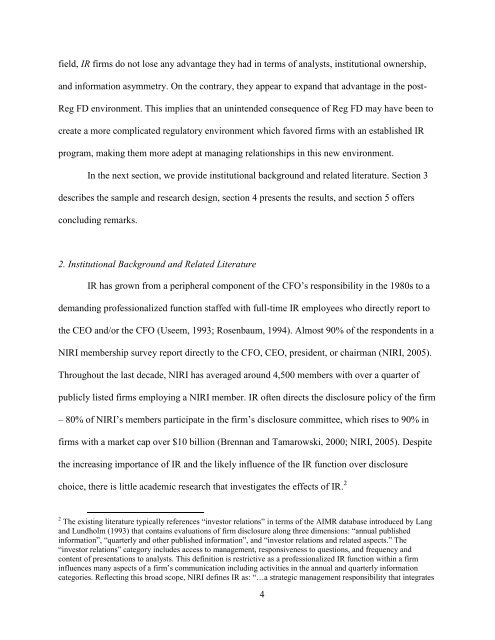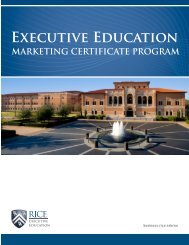Investor Relations and Regulation FD
Investor Relations and Regulation FD
Investor Relations and Regulation FD
You also want an ePaper? Increase the reach of your titles
YUMPU automatically turns print PDFs into web optimized ePapers that Google loves.
field, IR firms do not lose any advantage they had in terms of analysts, institutional ownership,<br />
<strong>and</strong> information asymmetry. On the contrary, they appear to exp<strong>and</strong> that advantage in the post-<br />
Reg <strong>FD</strong> environment. This implies that an unintended consequence of Reg <strong>FD</strong> may have been to<br />
create a more complicated regulatory environment which favored firms with an established IR<br />
program, making them more adept at managing relationships in this new environment.<br />
In the next section, we provide institutional background <strong>and</strong> related literature. Section 3<br />
describes the sample <strong>and</strong> research design, section 4 presents the results, <strong>and</strong> section 5 offers<br />
concluding remarks.<br />
2. Institutional Background <strong>and</strong> Related Literature<br />
IR has grown from a peripheral component of the CFO’s responsibility in the 1980s to a<br />
dem<strong>and</strong>ing professionalized function staffed with full-time IR employees who directly report to<br />
the CEO <strong>and</strong>/or the CFO (Useem, 1993; Rosenbaum, 1994). Almost 90% of the respondents in a<br />
NIRI membership survey report directly to the CFO, CEO, president, or chairman (NIRI, 2005).<br />
Throughout the last decade, NIRI has averaged around 4,500 members with over a quarter of<br />
publicly listed firms employing a NIRI member. IR often directs the disclosure policy of the firm<br />
– 80% of NIRI’s members participate in the firm’s disclosure committee, which rises to 90% in<br />
firms with a market cap over $10 billion (Brennan <strong>and</strong> Tamarowski, 2000; NIRI, 2005). Despite<br />
the increasing importance of IR <strong>and</strong> the likely influence of the IR function over disclosure<br />
choice, there is little academic research that investigates the effects of IR. 2<br />
2 The existing literature typically references “investor relations” in terms of the AIMR database introduced by Lang<br />
<strong>and</strong> Lundholm (1993) that contains evaluations of firm disclosure along three dimensions: “annual published<br />
information”, “quarterly <strong>and</strong> other published information”, <strong>and</strong> “investor relations <strong>and</strong> related aspects.” The<br />
“investor relations” category includes access to management, responsiveness to questions, <strong>and</strong> frequency <strong>and</strong><br />
content of presentations to analysts. This definition is restrictive as a professionalized IR function within a firm<br />
influences many aspects of a firm’s communication including activities in the annual <strong>and</strong> quarterly information<br />
categories. Reflecting this broad scope, NIRI defines IR as: “…a strategic management responsibility that integrates<br />
4
















